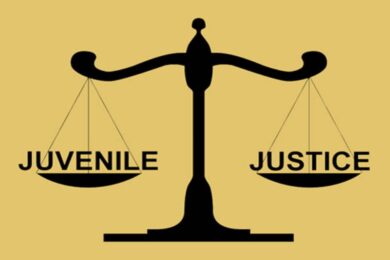Introduction
Juvenile justice refers to the legal framework that deals with individuals who are not yet adults and are accused of committing crimes. The system operates under the belief that children, due to their age and immaturity, should not be treated in the same way as adults and deserve a chance at rehabilitation rather than punishment.
India’s juvenile justice system has evolved over the years to strike a delicate balance between a reformative approach and the need to protect society. The growing involvement of juveniles in heinous crimes, such as the 2012 Nirbhaya case, has fueled a national debate: should juvenile offenders be given a second chance, or should they face punitive consequences?
1. Who is a Juvenile?
A juvenile is defined as a person below the age of 18 years under Indian law. This is aligned with the United Nations Convention on the Rights of the Child (UNCRC), to which India is a signatory.
The classification of juveniles is broadly categorized as:
Children in conflict with the law (CCL): Accused of committing an offense.
Children in need of care and protection (CNCP): Abandoned, abused, or neglected children.
2. Legislative Evolution of Juvenile Justice in India
a. Juvenile Justice Act, 1986
India’s first comprehensive juvenile law.
Focused on care, protection, and rehabilitation.
Applied uniformly to all juveniles below 18.
b. Juvenile Justice (Care and Protection of Children) Act, 2000
Passed to bring India in line with UNCRC obligations.
Introduced the idea of two categories: CCL and CNCP.
Established Juvenile Justice Boards (JJBs) and Child Welfare Committees (CWCs).
c. Juvenile Justice (Care and Protection of Children) Act, 2015
Enacted post-Nirbhaya case amid national outrage.
Allowed for juveniles aged 16 to 18 years to be tried as adults for heinous offenses.
Emphasized both reform and deterrence.
3. Structure of the Juvenile Justice System
Juvenile Justice Board (JJB)
Deals with cases of children in conflict with the law.
Comprises a Metropolitan Magistrate and two social workers (including one woman).
Ensures that the child is treated in a child-friendly manner.
Child Welfare Committee (CWC)
Handles cases of children in need of care and protection.
Responsible for rehabilitation, foster care, and adoption procedures.
Observation Homes and Special Homes
Observation homes: Temporary custody during inquiry.
Special homes: Long-term care for convicted juveniles.
4. Types of Offenses Under Juvenile Law
The Juvenile Justice Act categorizes offenses into:
Petty Offenses: Punishment less than 3 years.
Serious Offenses: Punishment between 3 to 7 years.
Heinous Offenses: Punishment more than 7 years (e.g., murder, rape).
Children aged 16-18 may be tried as adults only in heinous cases, subject to preliminary assessment by the JJB.
5. Reformative vs. Punitive Approach
Reformative Justice: The Traditional Stance
Based on the belief that children are capable of change.
Focuses on:
Psychological support
Vocational training
Education
Reintegration into society
This approach is supported by international treaties like the Beijing Rules and the UN Standard Minimum Rules for the Administration of Juvenile Justice.
Punitive Justice: Rising Public Demand
Advocates argue that some crimes are too serious to be treated lightly.
Victims deserve justice, and potential offenders need deterrence.
The 2015 amendment introduced a punitive element for heinous crimes by juveniles.
6. Landmark Cases
Nirbhaya Case (2012)
One of the accused was 17 years old and received only 3 years in a correctional home.
Sparked a national debate and led to the JJ Act, 2015, enabling trial of juveniles aged 16+ for heinous crimes as adults.
Salil Bali v. Union of India (2013)
Supreme Court upheld the constitutionality of the JJ Act, 2000, supporting a reformative model.
Dr. Subramanian Swamy v. Raju (2014)
Court laid down guidelines for the preliminary assessment of juveniles under the 2015 Act.
7. Challenges in the Juvenile Justice System
a. Preliminary Assessment
Difficult to accurately assess a juvenile’s mental capacity to commit and understand the consequences of a crime.
b. Lack of Infrastructure
Observation and special homes often lack funding, counselors, and proper facilities.
c. Socioeconomic Factors
Poverty, abuse, and lack of education increase vulnerability to criminal behavior.
d. Risk of Stigmatization
Trying juveniles as adults may harm their chance at reform.
Social reintegration becomes difficult.
e. Implementation Gaps
Inconsistencies in applying the Act across states.
Need for better-trained personnel in JJBs and CWCs.
8. Role of Institutions and NGOs
Organizations like National Commission for Protection of Child Rights (NCPCR) and Bachpan Bachao Andolan have played a crucial role in:
Promoting child rights
Conducting awareness campaigns
Monitoring rehabilitation centers
9. Way Forward
To strike the right balance between reform and punishment, India must:
Ensure standardized training for JJB and CWC members.
Improve infrastructure of juvenile homes and invest in psychosocial support.
Strengthen the rehabilitation ecosystem — education, counseling, skill development.
Promote community-based rehabilitation and reduce institutionalization.
Use data and criminological studies to shape evidence-based policies.
Conclusion
India’s juvenile justice system continues to grapple with the dichotomy between second chances and justice for victims. While juveniles should not be given a free pass for serious crimes, the solution does not lie solely in punitive measures. A nuanced approach — where heinous crimes are treated seriously, but with a strong emphasis on reform, reintegration, and rehabilitation — is key to a just and effective system. Balancing the rights of the child and the need for public safety is perhaps one of the greatest challenges of modern juvenile justice in India.








No Comments